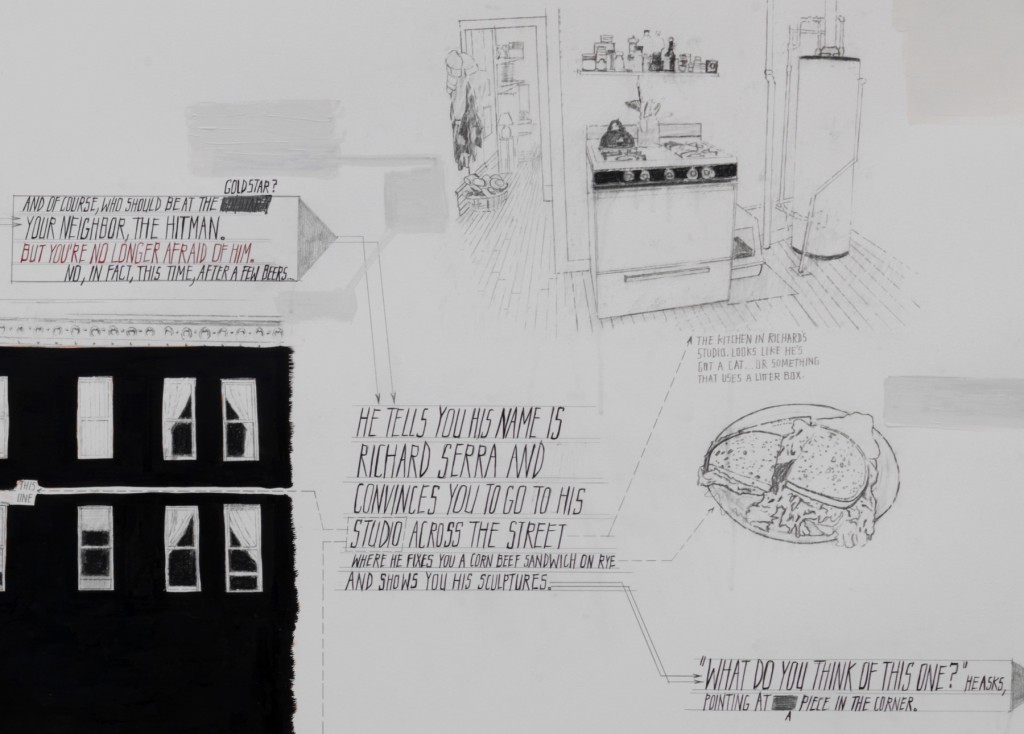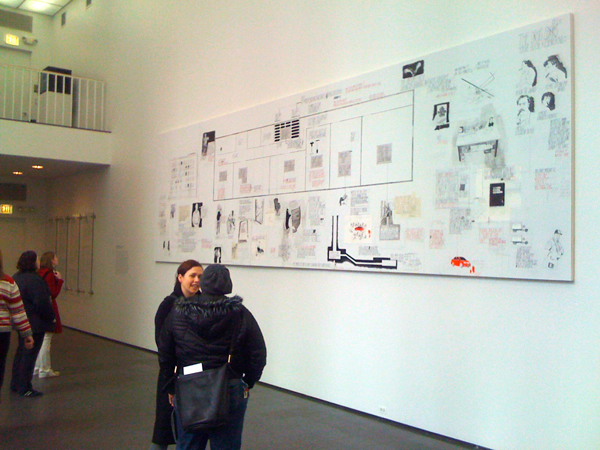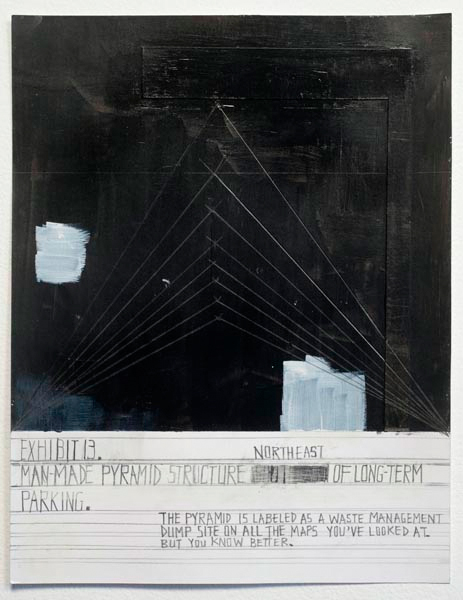Deb Sokolow invokes You, the audience. When engaging her work–wall drawings rife with text-narratives that revel in heist, hijinks and mystery, You are not a passive bystander. You are implicated as a character in her web, because she always writes in the second person. I spent some time talking to Deb about that second person device. It strikes me as particularly interesting because of its self-reflexiveness. Rather than sharing the artist’s gaze, looking through the lens of a camera say, the audience suddenly identifies with the model. You/We are in the drawing. You/We are being watched. Deb Sokolow is looking at us. Like an unnerving Welcome mat, Sokolow gives you a platform on which to stand.
Caroline Picard: How would you describe your development as an artist? Do you feel like there are different stages of Deb Sokolow work?
Deb Sokolow: Good question, maybe it’s a question I’d be able to answer better 10 or 20 years down the road. I’ve only been working in this current vein since 2003. That year, I was smack-dab in the middle of grad school, and it was the year that I had an art crisis; I realized I didn’t know what the heck I was doing or wanted to do as an artist. I had no personal investment in anything going on in the studio, so I stopped making work. I went home. I watched movies and ate Chinese take-out. “This is so much better than making art,” I told myself. But then when I started asking myself what was so compelling about watching movies, I realized that it was the stories, the narrative form that I loved, that I could get lost in. This was an A-ha! moment for me, because prior to this, I was making these blobby shapes out of glue and arranging them on table tops. It was boring. So boring! So I moved into working with the narrative form, making large, diagrammatic drawings on paper or multiple papers, always narrated by an anonymous, unreliable protagonist who’s only ever referred to as “you” and that’s what I’ve been doing for the last couple of years up until a couple of months ago where I decided to make a break with this, keep using the “you” but develop a new framework for the narrative and a new way of presenting it. So, in answer to your question, I guess I could say that I’ve recently entered dynasty #2, which is actually a pretty exciting place to be.

Deb Sokolow, "Dear Trusted Associate" (detail), 2008-2009. Graphite, charcoal, ink, acrylic on paper and on wall, approx. 40 feet long. Installed at the Van Abbemuseum in 2008 and at the Smart Museum of Art, University of Chicago, 2009-2010.
CP: How do you think about a single piece of paper?
DS: If it’s a small piece of paper and I’m just doing a small drawing on it, I tend to think a lot about formal concerns first. Usually, the first thought entering in my mind is, “Are you going to make a drawing smack-dab in the middle AGAIN?” Once I get over whatever frustrations I have with composition, though, and actually start drawing, I almost always erase or white-out whatever first pops up on the page, mostly because I’m never happy with it. I’m constantly erasing and whiting-out the whole way through.
CP: In some exhibits, you’ve installed instructions to the viewer about how to walk through the show. These “instructions” are given by way of a kind of unfolding, somewhat paranoid second person address. What happens when you guide the viewer that way? Where do you stand as “the artist” in relation to those instructions? (Does that make sense? I just think it’s interesting because in some way the narrator, the one addressing the viewer/reader, is also melding with that viewer/reader–the same thing happens with Calvino, right? Just because he says “You are sitting in your favorite chair, reading this book…” doesn’t mean that the literal reader is following his instructions….So basically, I think it’s interesting to think about how that functions in an architectural space, where the viewer can move around and through your directions. I was wondering if you could talk about that as a strategy…)
DS: I love giving instructions. I think it’s why I love the Fluxus movement. It’s a way to cut through the bull-shit self-referential layers of art and talk directly to a viewer. Whether a viewer wants to follow those directions or not is not the point. I love it when people tell me they read one of my pieces backwards, inadvertently. A story told backwards (i.e. the film, Memento) can be pretty fantastic. You mention Calvino, and I’ve always been interested in the way he plays with the structure of a story, but sometimes I lose interest when I read him because I don’t feel like I can develop a personal investment in his story, unlike other writers working with meta-fiction, such as David Foster Wallace or Muriel Spark or Iain Banks. For me, this is one of my biggest challenges: figuring out how to make something that someone could have a stake in. Creating some level of site specificity in the work, such as setting a piece’s story in the same location as where the piece is shown, where the viewer is reading it, is one way I’ve tried to make the work connect to readers. I’ve also tried the “Choose Your Own Adventure” format, wherein viewers take some charge of the story by deciding which narrative path they want to follow. I tried this for a piece at the Kemper Museum of Contemporary Art in Kansas City and another one at Inova [Institute of Visual Arts] in Milwaukee, and those two pieces were the most challenging I’ve ever made in terms of trying to fit the story and all the possible endings into a space in a way that wasn’t too confusing. When I think back to those two experiences, my head hurts a bit. More recently, I went with more of a performative approach… For a piece at the Van Abbemuseum in the Netherlands, I wrote its museum guards into the story as henchmen, following you, the reader, around the Van Abbemuseum, which was also featured in the story as a front for evil. When the piece was shown a second time at the Smart Museum in Chicago, the Smart Museum guards wore the same dress code as the Van Abbemuseum guards, and did some hovering around viewers who would read the piece.

Deb Sokolow, "You tell people you're working really hard on things these days," 2010. Graphite, charcoal, ink, acrylic, paper on panel, 7 ft x 25 ft. Installed at the Museum of Contemporary Art, Chicago, in 2010.
CP: I was wondering how you develop your narratives. How do go about incorporating “truths” and “fictions”? Do you make a distinction like that?
DS: I did work as a temporary receptionist in an office straight out of grad school. At the time, I felt lucky to have a job, since not too many people wanted to hire artists (artist = flake = bad worker). I also remember how much I initially hated it there when certain employees would bark orders at me and treat me like a complete idiot. I guess this is par for the course for most temp jobs, and the only way I survived this daily slog was to use the job as research and the employees as source material for characters for a piece. Once I figured this out, I started looking forward to going to work each day. And there was some dirty stuff going on in the office. The business had a connection to a city scandal that ended up in the news, but I shouldn’t go into it here! But this is usually the way I work, I end up writing about something I know. Or I at least start with what I know, and then develop various semi-fictitious or completely fictitious tangents from this. In answer to your question — I wouldn’t call any of this work painting. I’d call them drawings. Lately, the drawings have become more collage and painterly, but they’re still drawings.
CP: Having called upon it and incorporated it into your work so consistently over the years, at least to me as a viewer, I feel like the Sokolow 2nd person is almost like a friend to me. I see one of your works somewhere, and after exploring that piece usually feel like, “Well, the You is up to some crazy stuff again”–but I wonder what your experience of the You is.
DS: Whoever the “you” is that narrates everything I make is always the same person. It’s not me, although I have to admit that I might be becoming more like You. But maybe that was inevitable? I’ve needed to mentally put myself in You’s shoes for the last seven years in order to write in You’s voice, but it’s pretty simple to do. It just involves a lot of people watching and overloading on too many “What you need to know about identity theft NOW!” or “Meth lab hidden in junior high school locker” articles on Yahoo.com. None of this mental prep is as laborious as what a good method actor does to prepare for a role. I’m no Daniel Day Lewis! Strangely enough though, over the years, I’ve found myself becoming increasingly more suspicious of other people’s ulterior motives in pretty much any environment I find myself in. This evening, for example, when I was negotiating the icy sludge on the sidewalks from the bus to my apartment, there was this guy in front of me pushing a baby in a stroller and looking back over his shoulder at me oddly. Immediately, I thought: “Why is he looking at me? Is he kidnapping this baby and he thinks I might know he’s doing this and don’t I need to do something about it, but why isn’t anyone else noticing this?”
CP: Where did You came from?
DS: You happened when I was in the middle of making my second large drawing, called “Meeting People is Hard.” The piece is this large, text-driven, diagrammatic drawing based on my apartment building and the imagined floor plans of my neighbors’ apartments. Everything in the piece was initially written in the first person. There was a lot of “I did this” and “I saw this” and it felt too diaristic and self-involved. I wanted the storytelling to be more universal then this, to travel outside of my experience and attempt to speak to other people’s experiences. So I switched it to You and it changed the whole feel of the piece, it changed everything.

Deb Sokolow, "Exhibit 13. A Man-made Pyramid Structure," 2010. Graphite and acrylic on paper, 11” x 8 1⁄2”.
CP: Will you talk a little about your erasure marks?
DS: All the whiting-out and erasing is an important part of my process. But I’m constantly changing my mind about how I want something to be written or illustrated. I think of the physical remnants of these erasured and whited-out areas as the plumbing of the piece, it’s this infrastructure that has to be laid down before I can get to the final version of whatever it is I’m trying to do. My most recent work, writing mostly all-text episodes or chapters for a book (that will never fully exist) has a lot of plumbing. It’s a visual record of the writing process, layers and layers of errors underneath the final text.




